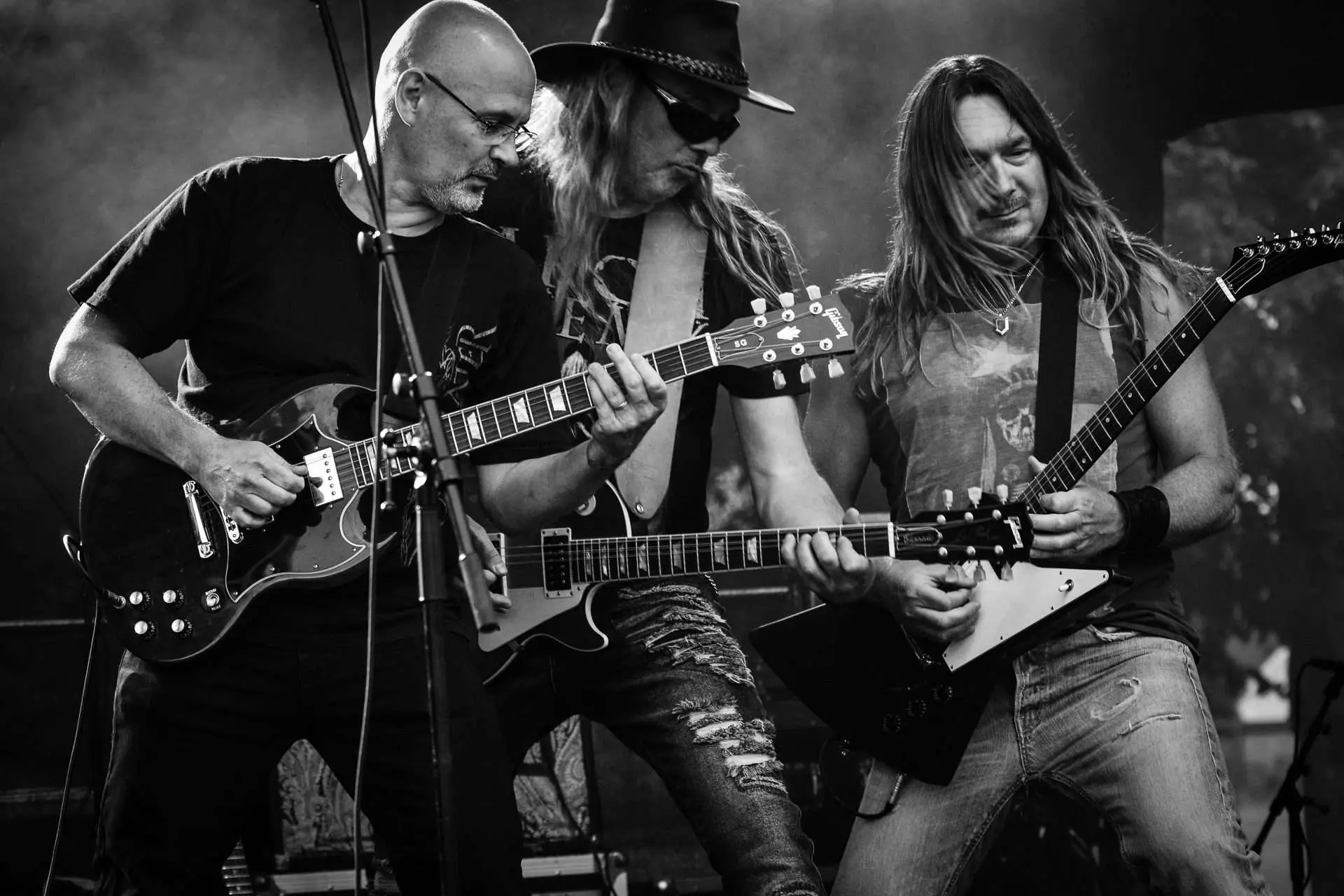What is a rhythm guitar? Rhythm guitar is a technique and role that provides the rhythmic pulse and harmony in a band’s music. While lead guitarists typically play solos and melodies, rhythm guitarists play the chords and provide the backbone of the song.
In a band,the rhythm section is made up of drums, bass guitar, and rhythm guitar. Its primary function is to keep time and provide the beat for the song. It provides the chords and strums along with the beat of the song, creating a foundation for the melody and solos to be played on top of.

Understanding Rhythm Guitar
Rhythm guitar is a technique that provides the rhythmic pulse and harmony of a song. It is a crucial element in music performances that helps to keep the tempo of the song and give it a steady beat.
Unlike lead guitar, rhythm guitar is not about playing flashy solos or complex riffs. Instead, it focuses on playing chords and maintaining the structure of the song. A rhythm guitarist is a key part of a band’s rhythm section that propels the song, beat, and melody forward.
Rhythm guitarists play chords and riffs in a way that forms the structure of the song, making it one of the most important roles a band member can have. They work together as a unit with the drummer, bassist, and other members of the rhythm section to create a cohesive sound.
Learning to play rhythm guitar can be challenging, but it is an essential skill for any guitarist. To be a good rhythm guitarist, you need to understand rhythm and timing, as well as chords and strumming patterns. Listening to the other musicians and keeping track of where you are in the song is also of utmost importance.
Related: What are microtonal guitars
The Role of a Rhythm Guitarist
A rhythm guitarist’s role is to provide the backbone of a song’s rhythm section. You work in conjunction with the drummer and bassist to provide the rhythmic pulse of the song. This means having a solid understanding of timing and being able to keep a steady beat.
In addition to rhythm, you also provide the harmony for the song. This means that you play the chords from the song’s chord progression. You need to be able to identify the chords that fit with the song and play them in a way that complements the melody.
As a rhythm guitarist, you need to be flexible in your playing. You should be able to play different genres and adapt to the needs of the band. You also need to be able to work with the lead guitarist to create a cohesive sound.
Basic Skills and Techniques
At first learning to play rhythm guitar can seem daunting, but with the right skills and techniques, you can quickly build a solid foundation for your playing. Here are some basic skills and techniques you should focus on as you start your journey:
Chords
Chords are the building blocks of rhythm guitar. They are made up of multiple notes played simultaneously, and are used to create harmony and convey emotion in music. As a beginner, you should start with basic open chords such as C, G, D, A, and E. Once you’ve mastered these, you can move on to more advanced chords such as barre chords and power chords.
Strumming
Strumming is the technique of moving your hand up and down across the strings to create a rhythmic sound. As a beginner, you should focus on getting comfortable with basic strumming patterns and alternate strumming. Practice keeping a steady rhythm and gradually increasing your speed.
Chord Progressions
Chord progressions are a sequence of chords played in a specific order. They are used to create the structure of a song and convey emotion. As a beginner, you should start with simple chord progressions such as I-IV-V and ii-V-I. Practice transitioning smoothly between chords and keeping a steady rhythm.
Fingerpicking
Fingerpicking is a technique where you use your fingers to pluck the strings instead of a pick. It allows for more intricate and melodic playing. As a beginner, you should start with basic fingerpicking patterns and gradually increase the complexity.
Triads
Triads are chords made up of three notes played simultaneously. They are used to create harmony and convey emotion in music. As a beginner, you should start with basic triads such as major and minor triads. Practice transitioning smoothly between them and incorporating them into your playing.
This beginner’s guide to rhythm guitar should give you a solid foundation to start your journey. Remember to practice regularly and focus on building your skills and techniques. With time and dedication, you’ll be playing rhythm guitar like a pro in no time!

Advanced Techniques
Once you have mastered the basics of rhythm guitar, it’s time to move on to more advanced techniques. These techniques will help you add more depth and complexity to your playing, and make you stand out as a skilled guitarist.
Hammer-ons and Pull-offs
Hammer-ons and pull-offs are techniques used to create a smooth, legato sound when playing guitar. A hammer-on is when you play a note and then use your left hand to hammer down onto a higher fret to produce a new note without plucking the string again. A pull-off is the opposite, where you pull your finger off the string to produce a new note without plucking the string again.
Arpeggios and Scales
Arpeggios and scales are essential for playing solos and riffs. An arpeggio is a broken chord where you play each note of the chord individually. Scales are a series of notes played in a specific order. Learning arpeggios and scales will help you to improvise and create your own solos and riffs.
Related: Are Electric Guitars Easier To Press?
Chord Changes and Licks
As a rhythm guitarist, your primary role is to provide the harmonic and rhythmic backing for a song. However, you can also add some flair to your playing by incorporating chord changes and licks. Chord changes are when you change the chord you are playing to create a different sound. Licks are short, repeated phrases that can be used to add interest to your playing.
Related: What Is A Guitar Tuner?
Palm Muting
Palm muting is a technique that involves resting the edge of your picking hand on the strings near the bridge to create a muted sound. This technique is often used in heavy metal and punk rock music to create a chugging, rhythmic sound.
In conclusion, mastering these advanced techniques will take time and practice. However, incorporating them into your playing will help you to become a more skilled and versatile guitarist.
Related: What Is A Guitar Combo Amp?
Understanding Timing and Beat
To understand rhythm guitar, you need to understand timing and beat. Beat is the pulse of the music, and timing is how notes are arranged in relation to the beat.
The beat is the underlying pulse of the music. It’s what you tap your foot to or nod your head along with. The tempo is the speed at which the beat is played.
To play rhythm guitar, you need to have a good sense of timing. Start by practicing with a metronome, playing quarter notes, then eighth notes, and finally sixteenth notes. Once you have a good sense of timing, you can start playing on-beat and upbeat rhythms.
Related: What Is A Resonator Guitar?
Influence of Other Instruments
When it comes to playing rhythm guitar, it’s important to consider the influence of other instruments in the band. The bass guitar, drums, percussion, and keyboards all play a crucial role in creating the overall rhythm and sound of the music.
The bass guitar often provides the foundation of the rhythm section, playing a repetitive pattern that helps to establish the groove of the song. As a rhythm guitarist, you’ll need to work closely with the bassist to ensure that your playing complements theirs. This may involve playing simple chord progressions that fit in with the bass line or adding small embellishments that enhance the overall sound.
Drums and percussion are also essential to creating a solid rhythm. The drummer is responsible for keeping time and establishing the beat, while percussion instruments can add texture and complexity to the rhythm section. As a rhythm guitarist, you’ll need to be aware of the drummer’s playing and adjust your own playing accordingly. For example, you might play more sparsely during a drum fill or accentuate certain beats to create a more dynamic sound.
Keyboards can also play a significant role in the rhythm section, particularly in genres like funk and soul. Keyboard players often play repetitive patterns that complement the bass and drums, adding a layer of complexity to the rhythm. As a rhythm guitarist, you might need to adjust your playing to fit in with the keyboard parts, perhaps by playing simpler chord progressions or adding more rhythmic elements to your playing.
Conclusion
Rhythm guitar is not just about strumming chords—it’s the heartbeat of a band’s music. Rhythm guitarists provide the essential pulse, harmony, and structure that keep a song moving forward. Their collaboration with the rhythm section, including drums, bass, and sometimes keyboards, is crucial in creating a cohesive sound.
In your pursuit of mastering rhythm guitar, remember that practice and dedication are your greatest allies. Over time, as you refine your skills and adapt to various musical contexts, you’ll find yourself not just playing rhythm guitar, but anchoring the very essence of the music itself.
Related: Why Do Guitarists Wear Wristbands?
